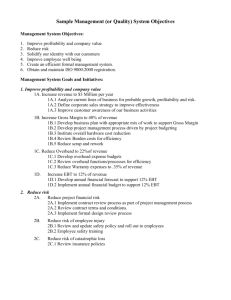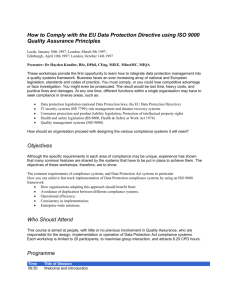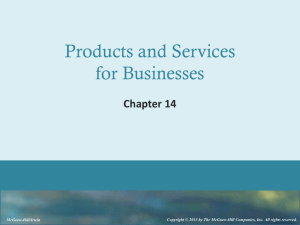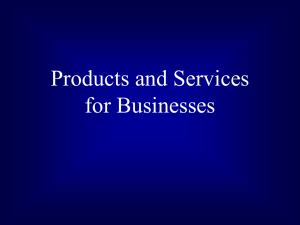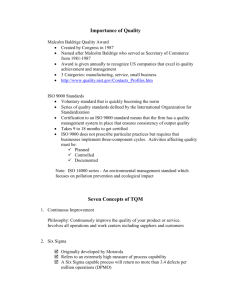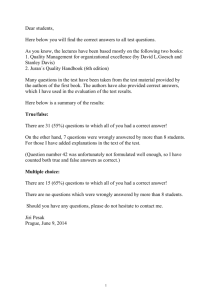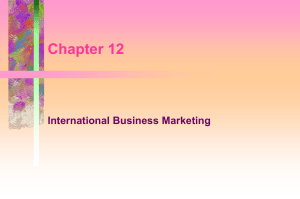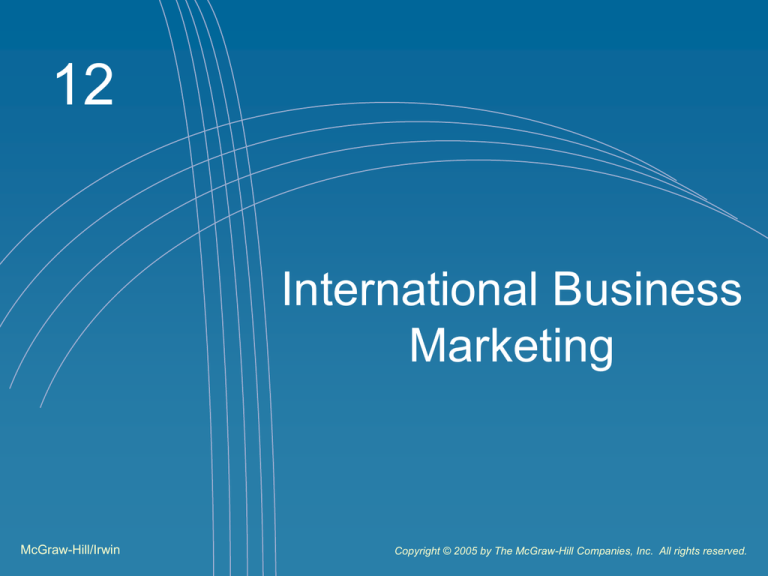
12
International Business
Marketing
McGraw-Hill/Irwin
Copyright © 2005 by The McGraw-Hill Companies, Inc. All rights reserved.
Agenda
The Scope and Challenge of International Business
Marketing
Export Opportunities and Challenges
Stages of Economic Development
The International Business Environment
International Law
Domestic Laws in Foreign Markets
International Entry Strategies
Product and Service Strategy
Managing the International Promotion Effort
Managing the International Distribution System
Pricing Strategy
12-2
The Scope and Challenge of
International Business Marketing
Three types of interactions that U.S. firms
may have with foreign firms:
• They may be supplied by them
• They may compete against them in this
country
• They may export goods and/or services to a
foreign country and compete with them
there.
12-3
Export Opportunities and Challenges
Exporting allows companies to:
• Increase growth potential beyond domestic capacity
• Expand into new markets with existing or new
products or services
• Add product or service lines
• Extend product or service life cycles
• Improve profitability and competitiveness
• Save existing jobs and generate new ones
• Gain favorable publicity and recognition
• Anticipate domestic market changes
• Meet the needs of global customers
• Anticipate domestic market changes
12-4
Export Opportunities and Challenges
To be successful in exporting, a company must:
•
•
•
•
•
•
Analyze capabilities of business accurately.
Know export potential of products and services.
Identify foreign markets.
Understand export logistics and distribution channels.
Understand culture!
Develop international business relationships and
market entry strategies.
For these reasons, many businesses never enter
the global marketplace; the task seems too
daunting and time consuming.
12-5
International business marketing means travel.
12-6
A huge volume of international business
marketing transactions are continuously in
process between companies in countries all over
the world.
The process has been going on since products
started to be produced and sold.
12-7
12-8
12-9
International Entry Strategies
Exporting
The Internet
Contractual Agreements
• Licensing
• Franchising
• Joint Ventures
Direct Foreign Investment
• Manufacturing
• Assembly Operations
• Turnkey Operations
12-10
Product and Service Strategy
Product Positioning
Adaptation Versus Standardization
• Product adaptation
Strategically changing product to meet local
needs.
• Product standardization
Product originally designed for domestic market
is exported to other countries with virtually no
change, except perhaps for translation of words
and other cosmetic touches.
12-11
Managing the International
Promotion Effort
International Advertising
International Sales Promotion
International Publicity
Trends in International Direct,
Interactive, and Internet Marketing
12-12
Managing the International
Distribution Effort
• American-based Export Intermediaries
Brokers and agents
Export management companies
(EMCs)
Export trading companies (ETCs)
Export trading company cooperatives
Piggyback arrangements
12-13
Managing the International
Distribution Effort
• Foreign-based Export Intermediaries
Foreign sales agents
Foreign distributors
• Direct Marketing
12-14
Managing the International
Pricing Effort
Pricing Strategy
• Company Factors
Global Corporate Objectives
Cost-Based Approaches
Transfer Price Policies
• Market Factors
Income Levels and Market Segments
Competitive Structure
Channel Structure
Gray Markets
12-15
Managing the International
Pricing Effort
Pricing Strategy
• Environmental Factors
Foreign Exchange Rates
Inflation Rates
Price Controls
Countertrade
12-16
Countertrade
Global trade does not always involve cash; instead, countertrade
(CT), or barter, involves one-time exchange of goods/services for
other goods/services.
Half of Fortune 500 companies have used barter in
some way.
~300,000 companies trade through corporate barter.
More than 80 nations currently use CT.
More than 30 percent of world trade involves CT.
Examples
Xerox sells $100 million/year in copiers and printers to
Brazil, with payment in Brazilian steel and Venetian
blinds.
General Dynamics sells F-16 fighter jets to Turkey in
exchange for Turkish products.
12-17
The International Business
Environment
The Buying Process
• Buying Centers
Although objectives of purchasing personnel may
be universal, makeup of buying centers and
interactions between members of buying centers
will vary by country.
In international marketing, it is often more difficult
to:
• Identify members of buying center.
• Determine their role in buying process.
• Communicate appropriate information to them.
12-18
The International Business
Environment
Cultural Dynamics
• Required Adaptations
Different cultural systems can produce
divergent negotiating styles shaped by
each nation’s culture, geography, history,
and political system.
Marketers should be aware of complex
buying process, socio-cultural dynamics,
political-legal environment, and
economic environment in foreign markets
12-19
12-20
The International Business
Environment
Cultural Dynamics (continued)
• Cultural Imperatives - Business customs
and expectations that must be met and
conformed to if relationships are to be
successful.
• Cultural Adiaphora - Behaviors and
customs that outsiders may wish to conform to
or participate in, but that are not required.
• Cultural Exclusives - Customs or behaviors
from which the foreigner is excluded.
12-21
The International Business
Environment
Cultural Dynamics (continued)
• Basic Requirements for International Marketing
Success Depends on
Knowledge of business culture, management
attitudes, and business methods existing in
country and willingness to accommodate
differences.
Ability to understand the other market’s
perspective is critical. Most of us tend to think
everyone else sees things as we do (known as
self-reference error ). Marketing mix should be
based on customer’s preferences, not your own.
12-22
The International Business
Environment
The Political and Legal Environment
• Risks of confiscation, expropriation, and
domestication.
• Personal risk.
12-23
The International Business
Environment
The Political and Legal Environment
• The Political Environment
In day-to-day operations, U.S. domestic
business marketers tend to ignore impact of
political environment.
U.S. political environment is relatively stable
and predictable … but this is not true
everywhere.
Political change can mean new competitive
disadvantages for foreign companies or even a
company’s expropriation (or even confiscation).
12-24
The International Business
Environment
The Political and Legal Environment
• The Political Environment
Conflicting signals
Trade barriers
12-25
Foreign Trade Barriers
Import policies —tariffs and other import charges,
restrictions, licensing, or barriers
Standards, testing, labeling, and certification
Government procurement —”buy national” policies and
closed bidding
Export subsidies —export financing on preferential
terms
Lack of intellectual property protection—inadequate
patent/trademark protection
Service barriers —regulation of international data flows
Investment barriers—restrictions on transferring
earnings and capital
Regulations and standards and discriminatory taxation
Other barriers —bribery and corruption
12-26
12-27
The International Business
Environment
The Political and Legal Environment
• The Legal Environment
• Local Legal Systems
Common law systems
Code (written) law systems
Islamic law systems
12-28
Local Legal Systems Explained
Common law systems base interpretation of
law on prior court rulings (legal precedents and
customs). US system.
Code (written) law systems rely on statutes
and codes for interpretation of law. There is
little "interpretation," so law must be detailed
enough to prescribe appropriate and
inappropriate actions. Majority of world's
governments rely on code law system.
Islamic law systems rely on legal interpretation
of Koran.
12-29
The International Business
Environment
The Political and Legal Environment
• Antitrust Laws
• Foreign Corrupt Practices Act of 1977
12-30
International Law
Treaties of friendship, commerce, and
navigation (FCNs)
• usually guarantee “national treatment” to foreign
company—that it will not be discriminated against
by nation's laws and judiciary
International Monetary Fund (IMF) and
General Agreement on Tariffs and Trade
(GATT)
• part of limited body of effective international law.
Both agreements identify acceptable and
nonacceptable behavior for member nations.
12-31
International Law
The United Nations Commission on
International Trade Law (UNCITRAL)
• promotes a uniform commercial code for whole world.
North American Free Trade Agreement (NAFTA)
• purpose is to increase trade and business between
trading partners, U.S., Canada, and Mexico
12-32
Domestic Laws in Foreign Markets
Differing Legal Systems
12-33
ISO 9000 Certification
ISO = International organization for
standardization
ISO 9000 Certification: a series of standards that
include:
• Effective quality system
• Valid measurements and calibration
• Appropriate statistical techniques
• Lot control, part tracing, record keeping
• Internal process auditing
• Employee quality training
(continued)
12-34
ISO 9000 Certification
Mandates:
• Define appropriate quality standards
• Document processes
• Prove consistent adherence to both
Required by U.S. Dept. of Defense, Japan,
European Community, and others. Requirement
includes second-tier subassembly and component
makers (and their suppliers, etc.).
(continued)
12-35
ISO 9000 Certification
Prior to ISO 9000, most companies had
their own versions of quality systems
(many modeled on military specifications).
Certification assures customers that
suppliers have capabilities and systems to
provide high-quality goods. (Doesn’t assure
that particular products are high quality,
just the standards of the system they were
produced under.)
(continued)
12-36
ISO 9000 Certification
Other International Standards receiving
attention:
• AS 9000 (aerospace)
• ISO 14000 (environmental management)
• SA 8000 (social accountability)
(continued)
12-37
ISO 9000 Certification
ISO creates standards; typically,
consultants help company adapt systems
to meet the standards. When ready, a
certification company audits the systems
and awards certification (and provides
periodic checking).
Adoption cost = ~$250,000–$500,000 for
average-size plan operation.
(continued)
12-38
Why Is ISO 9000
a Marketing Issue?
If customer does not require it, ISO 9000
certification can be a differential advantage.
If customer does require ISO 9000, marketers
ensure that customer needs are met. If
marketing is confident that their quality
department can handle ISO requirement,
marketing can deal with other aspects of
customer’s needs. If marketing is not sure,
then they need to be involved until they are.
This is true of any customer requirement (e.g.,
technical, delivery, packaging).
(continued)
12-39
Why Is ISO 9000
a Marketing Issue?
Keep in mind that marketers decide which
customers to serve with what marketing
mixes. For example, marketing can decide
that it is in the company’s best interest to
target customers who require ISO 9000, but
not approach customers who require
aerospace 9000.
12-40
Summary
To be a successful international marketer, you
need to appreciate other cultures and be a
continuously learning student of their dynamic
business practices, cultures, legal systems,
political systems, and competitive
environments.
12-41

